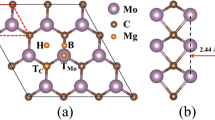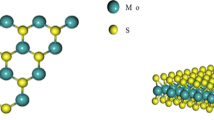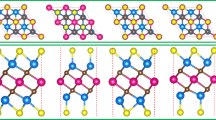Abstract
The electrochemical performance of double transition metal MoWC MXene has been examined by employing first principles approach for its popular usage as an efficient anode material in Li-ion batteries. The thermodynamic stability is determined using ab-initio molecular dynamics, geometry optimization and phonon dispersion calculations. The electronic structural calculations reveal that the MoWC monolayer exhibits high electronic conduction. Further, the low diffusion barrier of 0.040 eV on W-layer side and 0.029 eV on Mo-layer side of MoWC monolayer have been observed in present study. Moreover, the charge storage capacity of 670 mAh g−1 is predicted for the respective material, which indicates its better electrochemical performance as compared to their single metal carbides Mo2C and W2C MXenes. Also, the low average working voltage (~ 0.44 V) of MoWC MXene suggests its application as a potential candidate for anode material in Li-ion batteries.
Graphical abstract









Similar content being viewed by others
References
Tarascon JM, Armand M (2001) Issues and challenges facing rechargeable lithium batteries. Nature 414:359–367. https://doi.org/10.1038/35104644
Li H, Wang Z, Chen L, Huang X (2009) Research on advanced materials for Li-ion batteries. Adv Mater 21:4593–4607. https://doi.org/10.1002/adma.200901710
Goodenough JB, Kim Y (2009) Challenges for rechargeable Li batteries. Chem Mater 22:587–603. https://doi.org/10.1021/cm901452z
Dell R, Rand DAJ (2001) Energy storage a key technology for global energy sustainability. J Power Sources 100:2–17. https://doi.org/10.1016/S0378-7753(01)00894-1
Naguib M, Mochalin VN, Barsoum MW, Gogotsi Y (2014) 25th anniversary article: MXenes: a new family of two-dimensional materials. Adv Mater 26:992–1005. https://doi.org/10.1002/adma.201304138
Ong SP, Chevrier VL, Hautier G, Jain A, Moore C, Kim S, Maa X, Ceder G (2011) Voltage, stability and diffusion barrier differences between sodium-ion and lithium-ion intercalation materials. Energy Environ Sci 4:3680–3688. https://doi.org/10.1039/C1EE01782A
Urban A, Seo DH, Ceder G (2016) Computational understanding of Li-ion batteries. Comput Mater 2:16002. https://doi.org/10.1038/npjcompumats.2016.10
Mehta V, Tankeshwar K, Saini HS (2018) Li-adsorption on doped Mo2C monolayer: a novel electrode material for Li-ion batteries. AIP Conf Proc 1942:140047. https://doi.org/10.1063/1.5029178
Mehta V, Tankeshwar K, Saini HS (2018) Ab-initio study of electronic and magnetic properties of Co-doped Mo2C monolayer. AIP Conf Proc 1953:030109. https://doi.org/10.1063/1.5032444
Mehta V, Tankeshwar K, Saini HS (2019) Prediction of Mo2CF2 monolayer as a novel anode material for Li-ion batteries: a first principle study. AIP Conf Proc 2115:030576. https://doi.org/10.1063/1.5113415
Mehta V, Tankeshwar K, Saini HS (2020) First principles study of Mo2N monolayer as potential anode material for na-ion batteries. AIP Conf Proc 2265:030658
Zhou Y, Geng CA (2017) MoO2 sheet as a promising electrode material: ultrafast Li-diffusion and astonishing Li-storage capacity. Nanotechnology 28:105402. https://doi.org/10.1088/1361-6528/aa56d0
Mortazavi M, Wang C, Deng JK, Shenoy VB, Medhekar NV (2014) Ab initio characterization of layered MoS2 as anode for sodium-ion batteries. J Power Sources 268:279–286. https://doi.org/10.1016/j.jpowsour.2014.06.049
Naguib M, Mashtalir O, Carle J, Presser V, Lu J, Hultman L, Gogotsi Y, Barsoum MW (2012) Two-dimensional transition metal carbides. ACS Nano 6:1322–1331. https://doi.org/10.1021/nn204153h
Naguib M, Kurtoglu M, Presser V, Lu J, Niu J, Heon M, Hultman L, Gogotsi Y, Barsoum MW (2011) Two-dimensional nanocrystals produced by exfoliation of Ti3AlC2. Adv Mater 23:4248–4253. https://doi.org/10.1002/adma.201102306
Eklund P, Beckers M, Jansson U, Hogberg H, Hultman L (2010) The Mn + 1AXn phases: materials science and thin-film processing. Thin Solid Films 518:1851–1878. https://doi.org/10.1016/j.tsf.2009.07.184
Sun ZM (2011) Progress in research and development on MAX phases: a family of layered ternary compounds. Int Mater Rev 56:143–166. https://doi.org/10.1179/1743280410Y.0000000001
Naguib M, Halim J, Lu J, Cook KM, Hultman L, Gogotsi Y, Barsoum MW (2013) New two-dimensional niobium and vanadium carbides as promising materials for Li-ion batteries. J Am Chem Soc 135:15966–15969. https://doi.org/10.1021/ja405735d
Ghidiu M, Naguib M, Shi C, Mashtalir O, Pan LM, Zhang B, Yang J, Gogotsi Y, Billinge SJL, Barsoum MW (2014) Synthesis and characterization of two-dimensional Nb4C3 (MXene). Chem Commun 50:9517–9520. https://doi.org/10.1039/C4CC03366C
Harris KJ, Bugnet M, Naguib M, Barsoum MW, Goward GR (2015) Direct measurement of surface termination groups and their connectivity in the 2D MXene V2CTx using NMR spectroscopy. J Phys Chem C 119:13713–13720. https://doi.org/10.1021/acs.jpcc.5b03038
Meshkian R, Naslund L-A, Halim J, Lu J, Barsoumand MW, Rosen J (2015) Synthesis of two-dimensional molybdenum carbide, Mo2C, from the gallium based atomic laminate Mo2Ga2C. Scr Mater 108:147–150. https://doi.org/10.1016/j.scriptamat.2015.07.003
Tang Q, Zhou Z (2013) Graphene-analogous low-dimensional materials. Prog Mater Sci 58:1244–1316. https://doi.org/10.1016/j.pmatsci.2013.04.003
Mehta V, Saini HS, Srivastava S, Kashyap MK, Tankeshwar K (2019) S-functionalized Mo2C monolayer as a novel electrode material in Li-ion batteries. J Phys Chem C 123(41):25052–25060. https://doi.org/10.1021/acs.jpcc.9b05679
Anasori B, Xie Y, Beidaghi M, Lu J, Hosler BC, Hultman L, Kent PRC, Gogotsi Y, Barsoum MW (2015) Two-dimensional, ordered, double transition metals carbides (MXenes). ACS Nano 9:9507–9516. https://doi.org/10.1021/acsnano.5b03591
Hong W, Wyatt BC, Nemani SK, Anasori B (2020) Double transition-metal MXenes: atomistic design of two-dimensional carbides and nitrides. MRS Bull 45:850–861. https://doi.org/10.1557/mrs.2020.251
Ma SH, Jiao ZY, Huang XF (2014) First-principles study of ceramic material (Ti1−xNbx)2AlC compounds and its compressive behavior under pressure up to 55 GPa. J Alloys Compd 591:110–116. https://doi.org/10.1016/j.jallcom.2013.12.233
Wang Y, Wei W, Huang B, Dai Y (2019) Functionalized MXenes as ideal electrodes for Janus MoSSe. Phys Chem Chem Phys 21:70–76. https://doi.org/10.1039/C8CP06257A
Jin W, Wu S, Wang Z (2018) Structural, electronic and mechanical properties of two-dimensional janus transition metal carbides and nitrides. Physica E 103:307–313. https://doi.org/10.1016/j.physe.2018.06.024
Zhou J, Gao SH, Guo ZL, Sun ZM (2017) Ti-enhanced exfoliation of V2AlC into V2C MXene for lithium-ion battery anodes. Ceram Int 43:11450–11454. https://doi.org/10.1016/j.ceramint.2017.06.016
Bentzel GW, Lane NJ, Vogel SC, An K, Barsoum MW, Caspi EN (2015) A high-temperature neutron diffraction study of Nb2AlC and TiNbAlC. J Am Ceram Soc 98:940–947. https://doi.org/10.1111/jace.13366
Li Y-M, Chen W-G, Guo Y-L, Jiao Z-Y (2018) Theoretical investigations of TiNbC MXenes as anode materials for Li-ion batteries. J Alloy Compd. https://doi.org/10.1016/j.jallcom.2018.11.140
Li Y, Li L, Huang R, Zhang Y, Wen Y (2021) Computational screening of pristine and functionalized ordered TiVC MXenes as highly efficient anode materials for lithium-ion batteries. Nanoscale 13:2995–3001. https://doi.org/10.1039/D0NR08271F
Akgenc B (2019) Intriguing of two-dimensional Janus surface-functionalized MXenes: an ab-initio calculation. Comput Mater Sci 171:109231. https://doi.org/10.1016/j.commatsci.2019.109231
Liu H, Wang H, Jing Z, Wu K, Cheng Y, Xiao B (2020) Bare Mo-based ordered double-transition metal MXenes as high-performance anode materials for aluminum-ion batteries. J Phys Chem C 124(47):25769–25774. https://doi.org/10.1021/acs.jpcc.0c08901
Wang H, Jing Z, Liu H, Feng X, Meng G, Wu K, Cheng Y, Xiao B (2020) A high-throughput assessment of the adsorption capacity and Li-ion diffusion dynamics in Mo-based ordered double-transition-metal MXenes as anode materials for fast-charging LIBs. Nanoscale 12(48):24510–24526
Perdew JP, Burke K, Wang Y (1996) Generalized gradient approximation for the exchange-correlation hole of a many-electron system. Phys Rev B 54:16533–16539. https://doi.org/10.1103/physrevb.54.16533
Kresse G, Furthmüller J (1996) Efficient iterative schemes for ab initio total-energy calculations using a plane-wave basis set. Phys Rev B 54:11169–11186. https://doi.org/10.1103/physrevb.54.11169
Monkhorst HJ, Pack JD (1976) Special points for brillouin-zone integrations. Phys Rev B 13:5188–5192. https://doi.org/10.1103/PhysRevB.13.5188
Henkelman G, Uberuaga BP, Jónsson H (2000) A climbing image nudged elastic band method for finding saddle points and minimum energy paths. J Chem Phys 113:9901. https://doi.org/10.1063/1.1329672
Yu M, Trinkle DR (2011) Accurate and efficient algorithm for Bader charge integration. J Chem Phys 134:064111. https://doi.org/10.1063/1.3553716
Zhang Y (2017) First principles prediction of two-dimensional tungsten carbide (W2C) monolayer and its Li storage capability. Comput Condens Matter 10:35–38. https://doi.org/10.1016/j.cocom.2017.03.002
Sharmaa A, Khana MS, Khanb MS, Husaina M (2021) Ab initio study of molybdenum sulfo-selenides alloy as a flexible anode for sodium-ion batteries. Appl Surf Sci 536:147973. https://doi.org/10.1016/j.apsusc.2020.147973
Henkelman G, Jónsson H (2000) Improved tangent estimate in the nudged elastic band method for finding minimum energy paths and saddle points. J Chem Phys 113:9978–9985. https://doi.org/10.1063/1.1323224
Acknowledgements
The authors acknowledge the Pt. Deendayal Upadhyaya Innovation and Incubation Centre (PDUIIC), Guru Jambheshwar University of Science and Technology (GJUS&T), Hisar, India for providing the computational facility under RUSA grant.
Author information
Authors and Affiliations
Corresponding author
Ethics declarations
Conflict of interest
The authors have no conflict of interest to declare that are relevant to the content of this article.
Additional information
Handling Editor: M. Grant Norton.
Publisher's Note
Springer Nature remains neutral with regard to jurisdictional claims in published maps and institutional affiliations.
Rights and permissions
About this article
Cite this article
Mehta, V., Saini, H.S., Srivastava, S. et al. Ultralow diffusion barrier of double transition metal MoWC monolayer as Li-ion battery anode. J Mater Sci 57, 10702–10713 (2022). https://doi.org/10.1007/s10853-022-07237-1
Received:
Accepted:
Published:
Issue Date:
DOI: https://doi.org/10.1007/s10853-022-07237-1




